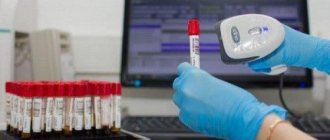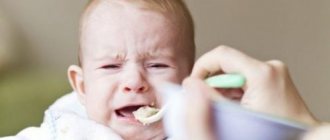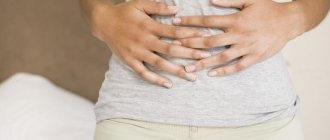Causes
In children under one year of age, diarrhea is a common occurrence, rarely indicating a serious pathology in the baby’s body, even if mucus is present in the stool. This is explained by the peculiarities of the children's digestive system - the baby's intestines do not function fully. Intestinal upset in an infant can be triggered by the introduction of a new product as complementary food. Reasons for the development of symptoms in infants:
- Maternal malnutrition;
- Digestive disorders that provoked dysbacteriosis;
- Excessive food intake;
- Intolerance to milk, formula, products;
- Intestinal infection;
- Congenital pathologies of the gastrointestinal tract;
- Teething.
Loose, dark-colored stools with mucus are considered normal in a one-month-old baby. This is how meconium comes out. The digestive system of a baby in the first month of life adapts to new conditions. If a 4-5 month old baby is teething, diarrhea is possible. In this case, the process is not dangerous and goes away after some time.
External factors and diseases influence the stool of a child over one year old. Causes of diarrhea in older children:
- Consumption of low-quality products or products that have expired;
- Emotional disorder;
- Intoxication of the body;
- Intestinal infection;
- Diseases of the gastrointestinal tract;
- Dysbacteriosis that developed as a result of antibiotic therapy.
A serious cause for concern is diarrhea with mucus, which can indicate the presence of an acute intestinal infection.
Reasons for deviation from the norm
Finding negative factors that lead to diarrhea is very important to determine a treatment strategy.
Photo of a stool in a diaper
The main reasons for the appearance of loose stools:
- intestinal infections that develop due to an imperfect immune response;
- lactose intolerance, when diarrhea is caused by a deficiency of the enzyme that processes milk sugar;
- dysbacteriosis, as a result of a nursing mother taking antibacterial drugs;
- teething;
- gluten intolerance;
- violation of the diet of a nursing mother;
- viral disease, enterocolitis;
- introduction of complementary foods that are not appropriate for age and digestive system capabilities;
- gastroenteritis;
- violation of hygiene rules for child care.
The cause of green stool may be bacterial infections caused by staphylococcus. If there is a delay in diagnosis, a child with this pathology quickly develops intoxication.
Associated symptoms
Often, diarrhea with mucus occurs due to reasons that do not pose a threat to the child’s health. If diarrhea is caused by a chronic disease or infection, other symptoms may also occur:
- Weakness, fever;
- Blood in liquid stool;
- Green or white flakes in stool;
- Yellow, green, black diarrhea;
- Frequent loose stools – more than 10 times a day;
- Nausea, vomiting, abdominal pain.
The listed signs require immediate medical intervention, especially if present in a newborn baby.
Treatment
The treatment plan is based on the diagnosis.
- Infectious diseases are treated in a hospital; antibiotics, antiviral and antiseptic drugs are used for therapy
- When it comes to dysbiosis, pro- and prebiotics come to the rescue
- Inflammations of internal organs are also treated in hospital, under the supervision of a specialist.
- If diarrhea is not the result of an intestinal infection, drugs that inhibit peristalsis are prescribed
- The first days a strict diet is followed, based on a significant reduction in the load on the gastrointestinal tract
Diseases that cause diarrhea with mucus
Certain diseases provoke loose stools with mucus, sometimes streaked with blood. Common childhood infections include:
- Salmonellosis;
- Dysentery;
- Rotavirus infection;
- Staphylococcus.
Salmonellosis
Bacterial infection acquired through dirty water or spoiled food. The disease is severe in newborns up to one year old. The child feels weak and is capricious. The temperature rises to 39 degrees.
Later, diarrhea begins. Diarrhea is frequent - more than 10 times a day. The stool has a green tint. Diarrhea contains mucus. After a week, you can see blood in the stool.
Salmonellosis is an extremely dangerous disease for children. With complications, infectious-toxic shock develops.
Salmonellosis disease
Dysentery
A common bacterial infection in preschool children. The incubation period lasts up to a week. Depending on the form, the disease has different symptoms and duration. The disease begins with an increase in temperature, sometimes to critical levels. The baby has a headache. Nausea and vomiting appear. Frequent bowel movements - up to 30 times a day. The stool is liquid, mucous mixed with blood. In severe form - transparent mucus with a green admixture.
Rotavirus infection
An intestinal infection affecting the upper respiratory tract. Most common among children from 6 months to 5 years.
In the first days after infection, there are no symptoms of the disease. Then a sign of poisoning appears - the patient feels sick and vomits.
Sometimes the disease begins like a common cold - with a cough and runny nose, without fever. Then comes abdominal pain and upset stool. At first, the urge is frequent - up to 15 times. The color of the stool is yellow, the consistency is liquid. With diarrhea, stools with a sour odor. Foam and mucus may be seen in loose stools. Later, the stool thickens and becomes grayish in color.
Dysbacteriosis
A pathology in which the intestinal microflora is disturbed. There is a predominance of harmful bacteria over beneficial ones. This condition is often observed in young children and even infants.
The disease is manifested by stool instability - alternating constipation and diarrhea. Diarrhea has an unnatural color and there is mucus in it. The patient's appetite worsens and abdominal cramps appear.
Often during diagnosis it turns out that dysbiosis is caused by another, more serious disease.
Where does mucus come from?
Liquid stool with mucus in a newborn is a variant of the norm. In the first days of life, he excretes original feces - meconium.
It contains:
- water;
- bile;
- slime;
- lactobacilli;
- coli;
- amniotic fluid swallowed during the prenatal period;
- epithelial cells.
Meconium is formed before birth and is expelled in the first 2-3 days of life. The consistency of original feces is viscous, odorless, and dark in color.
The stool then becomes yellow in color and has a jelly-like or watery texture. The persistence of loose stools with mucus in an infant during the first 3-4 months of life should not cause concern. The digestion of mother's milk is accompanied by the formation of acids and alkalis in the baby's intestines, so the formation of mucus is a kind of protection against the aggressive consequences of biochemical reactions in the digestive system.
Normally, loose stools with mucus are rare in infants, because these inclusions are mixed with feces in the large intestine. If they occasionally appear in the form of separate fragments, there is no cause for concern.
Parents' actions
Worried parents often don’t know what to do if their little child feels unwell. The first thing the mother should do is see a doctor. When the doctor listens to the complaints, performs an initial examination, prescribes treatment or gives a referral for examination to clarify the diagnosis. Before visiting the pediatrician, you need to take the following steps:
- If an older child has diarrhea with mucus, limit food intake. The recommendation does not apply to infants.
- Increase your drinking volume. Pure mineral water without carbon and herbal teas are recommended.
- It is allowed to give the baby sorbents. Smecta is suitable for little ones. Older children will take activated charcoal.
The main thing is to prevent dehydration. To replenish the water-salt balance, parents can give the child a rehydration solution purchased at the pharmacy. Closely monitor the patient's condition. Dry lips, dry skin, lack of urine – all of the above are considered signs of dehydration. If you suspect, you need to call an ambulance.
After the baby’s condition has stabilized, it is necessary to adhere to a gentle diet for some time so that the digestive system is fully restored.
First aid
What to do if a child has diarrhea with mucus? Of course, if we are talking about a baby, then it is best to immediately call a doctor. Even if you think there are no serious reasons for concern, this is a case when you should play it safe. But how can you alleviate the baby’s condition before a specialist arrives? Here are some tips to help you with this.
Drinking regime
Staying hydrated during diarrhea is very important. If this is not done, due to significant loss of fluid, dehydration can begin, which, in some cases, can even be fatal. Sound the alarm if you notice the following symptoms:
- Dry mucous membranes
- The baby cries without tears
- Prolonged absence of urination
- Urine becomes dark in color and smells like ammonia
- Saliva is thick and sticky
- Sunken eyes and dry skin
- Refusal to eat and drink
- Lethargy, drowsiness, weakness
- Rise or vice versa, decrease in temperature
To avoid dehydration, give your child something to drink after each bowel movement if they have mucus-filled diarrhea. The volume of fluid consumed should be at least 150 ml at a time, and at least two liters per day.
If the baby is vomiting, water should be given by the spoonful, but as often as possible.
An excellent alternative to water for digestive disorders are homemade compotes of bird cherry and blueberries, a decoction of chamomile and rose hips, as well as water-salt solutions (Regidron, Oralit), which will quickly restore the beneficial salts and trace elements lost during diarrhea.
Temperature
If the baby has a high temperature, it must be brought down. For this purpose, use only paracetamol-based drugs, since aspirin and analgin are contraindicated for use under 12 years of age.
Sorbents
To help the body cleanse itself of toxins and other harmful substances, give your baby enterosorbent. This can be done without a doctor's recommendation, as these medications are absolutely safe. From the pharmacy assortment you can choose Enterosgel, Smecta, Polyphepan, Polysorb, activated carbon. If there is no time or opportunity to run to the pharmacy, cook rice water. It is an excellent natural sorbent, and, moreover, perfectly fixes.
Additional recommendations
- Save the contents of the potty or diaper until the doctor arrives, so he can make a diagnosis faster and more accurately
- Wash your baby after every bowel movement
- If possible, stop eating. If your baby says he is hungry, offer him toasted white bread.
Diagnosis and treatment
If mucous diarrhea does not go away after a day, the doctor prescribes a laboratory examination of the child’s biological material and a hardware examination of the gastrointestinal tract. Only after determining the cause is appropriate treatment prescribed.
Diagnostics
The doctor will recommend a general blood test to assess the child’s condition and determine the severity of the disease. A stool test for dysbacteriosis will help determine the presence and types of microbes that cause diarrhea with mucus.
A stool test for worm eggs is mandatory.
Additionally, the doctor will prescribe an ultrasound examination of the gastrointestinal tract. The procedure is completely safe, does not cause discomfort in infants, and helps to identify various organ pathologies.
Treatment
First of all, therapy is aimed at eliminating the disease that caused the intestinal disorder. If diarrhea is caused by an intestinal infection or intoxication, the doctor prescribes an antibacterial drug that eliminates the microorganism. At the same time, a probiotic is prescribed to normalize the intestinal microflora. The most frequently prescribed drugs are Bifidumbacterin, Bifiform baby, Narine.
To remove toxins, sorbents are prescribed - Polysorb, Smecta. If your baby is sick, you can give Enterosgel. Sorbents are given first when a symptom appears. Activated carbon is recommended for children over 7 years of age.
If your baby has a fever, the doctor may prescribe Panadol or children's Paracetamol.
Diet
To restore the body after diarrhea, you need a strict diet. A baby who is under 1 year of age and who is breastfed can drink breast milk at the same intervals. Breast milk will help quickly replenish fluid lost during diarrhea.
Diarrhea in a one-year-old baby and older children - you need to reduce the amount of food and increase the volume of liquid. Remove heavy and irritating foods from your diet.
How does a newborn's stool change normally?
During intrauterine development of the gastrointestinal tract, the fetal intestine is completely sterile. Only after childbirth is it colonized by various bacteria - during passage through the birth canal, touching the skin, kissing, and breastfeeding. In this way, healthy intestinal microflora is formed.
Immediately after birth, the newborn begins to breastfeed and receives colostrum. It has laxative properties, and it is thanks to it that in the first two days the baby passes meconium (or, as it is also called, original feces). But according to its characteristics, it is black, sticky, dense. Normally, meconium is passed within the first 48 hours of life.
Around the third or fourth day, milk comes in, and the baby's stool becomes lighter. Subsequently, the stool of a breastfed baby can acquire any shade of yellow, green, or brown. It is quite difficult to trace the causes, and it is not necessary. This is the physiology of babies. The consistency is usually liquid, without a sharp unpleasant odor.
By the sixth week of life, the frequency of bowel movements decreases somewhat compared to the previous period: if before this the baby could poop 4, or even 5–6 times a day (sometimes in small portions), now it is 1–3 times a day. Some babies don't have a bowel movement every day, and that's okay too. In addition, the stool is no longer so liquid: it is now relatively formed feces.
It is worth saying that the type of feeding can also affect the color of the stool and its consistency. According to one large study1, breastfed infants were more likely to have yellow stools, while bottle-fed or formula-fed infants had 50% of their stools being green. In artificial babies, the stool is initially less liquid than in infants.
Normally, a baby's stool may contain a small amount of various impurities - white flakes, mucus, single streaks of blood, pieces of undigested food, etc.
Mucus is present in the stool of a newborn in most cases, but with a small amount it is difficult to detect its presence. The amount of mucus increases noticeably during active drooling in the baby.
Prevention
To avoid recurrent symptoms, you must adhere to simple rules:
- The child’s menu should be complete and varied, appropriate for age.
- Observe personal hygiene rules. Tell children about the need to wash their hands after going outside and to the toilet.
- Drink clean, filtered water.
- Avoid contact with sick people.
- Heat-treat vegetables and fruits.
Children's bodies are less resistant to various infections. Certain diseases that cause diarrhea with mucus can seriously affect health and even threaten life. It is important to seek medical help promptly, determine the cause and begin treatment to avoid unwanted consequences.
Baby's green stool
The child's stool suddenly began to look completely different, instead of yellowish it turned out to be green. What does it mean? Why does my baby have green stool? The reason is important. Greens in a diaper can be a completely normal and harmless manifestation of changes in the intestinal microflora or a symptom of a disease. Dark green, yellow-green, green stools with mucus, green diarrhea - when to worry and call a doctor, and when green stools are still in the “green zone,” explained pediatrician Anastasia Anatolyevna Nikulina.
— Anastasia Anatolyevna, what kind of stool should a healthy infant have and what deviations are acceptable?
— The color of the stool varies between babies who receive breast milk and those who are formula-fed. If greenery appears in the stool, and its consistency and frequency remain normal, this is acceptable.
| The normal stool rate for a breastfed baby is: yellow in color, mustard consistency. | The normal stool rate for a bottle-fed baby is: dark yellow in color, may contain white grains (undigested food), which will disappear over time. |
— What diseases can be a symptom of green stool in a newborn?
— Various diseases can provoke the appearance of green stools, primarily disturbances in the baby’s gastrointestinal tract and infections:
- liver or gallbladder dysfunction;
- pancreatic diseases;
- dysbacteriosis;
- bacterial infections;
- viral intestinal diseases;
- helminthic infestation;
- food allergy.
- Let's figure out what green stools mean in common problem situations.
- Situation 1. Green liquid stool in a baby
- If diarrhea occurs suddenly, is accompanied by vomiting, fever, intestinal colic - this is a disease. It can be caused by enteroviruses, pathogenic fungi, and intestinal bacteria. For example, staphylococci and streptococci, entering the child’s intestines, begin intensive reproduction and change the acidic environment to an alkaline one. Therefore, the color of the stool changes.
- Situation 2. Green feces due to dysbiosis in an infant
— Every baby encounters dysbacteriosis: it occurs during the formation of the necessary microflora in the intestines. The unnatural green color of stool due to dysbacteriosis is due to the content of dead leukocytes in the stool. They accumulate in the intestinal area and increase the inflammatory process. The stool turns green due to fermentation and putrefaction in the intestines. Other manifestations of dysbacteriosis include bloating, gas formation, and skin rash. The baby's stool will return to normal when the microflora is completely populated.
If the child is gaining weight well and nothing bothers him, then green stool is considered normal. Other symptoms will indicate the indigestibility of food.
Green stool in a baby - reasons
Green stool in a breastfed baby
| Green stool in a formula-fed baby
| Green loose stool, green foamy stool, or dark green stool in a baby
|
If the reasons mentioned do not apply to you, the cause of green stool may be harmful intestinal bacteria.
— For what symptoms of green stool in a child should you consult a doctor?
- Decreased appetite in the baby, increased body temperature, colic, abdominal pain, the appearance of bloody impurities and mucus in the stool, vomiting, rash on the body - such complaints should be a mandatory reason for a visit to the children's doctor. During the examination, he will recommend a list of studies to make the correct diagnosis.
If green stool appears during a change in diet, but the child has adequate weight gain, feels well, is active, and has a normal appetite, then there is no reason to worry. This may be a one-time occurrence that will disappear without any complaints.
Green stool in a child - what tests to take:
- blood and urine tests to determine the presence of inflammation in the body;
- coprogram - the presence of an inflammatory process in the intestines is assessed,
- stool analysis for dysbacteriosis - to assess intestinal microflora;
- biochemical blood test - checking the functioning of the digestive organs;
- scraping for enterobiasis - confirms or excludes a parasitic disease;
- ultrasound examination of the digestive system - to assess the functioning of the pancreas and liver.
— How to treat green stool at home?
— The child should be treated by a specialist. Therapy depends on the cause of the appearance of green impurities in the stool. In case of improper nutrition, a change in the diet of mother and child, a reduction in the volume of complementary foods, and selection of the correct complementary foods are prescribed.
If an infection is suspected, the child must be hospitalized in a specialized department, because only there can he receive adequate care.
Treatment of intestinal infection and green stool:
- drinking regime - to prevent dehydration;
- sorbents - to remove pathogenic toxins from the body;
- antibacterial drugs - prescribed when the causative agent of a bacterial intestinal infection is identified.
Non-infectious causes of green stool in a child - what to do:
- lactose intolerance - lactose is excluded from the child’s diet;
- allergic reaction - the allergen is determined and excluded from the diet of an artificial child or a nursing mother;
- helminthic infestation - give anthelmintic drugs;
- dysbiosis - correction of intestinal microflora with pre- and probiotics.
— What can be considered the best prevention of green stool?
— Timely and correct introduction of complementary foods, nutrition without overeating, diet by the mother, individually selected milk formula will contribute to comfortable digestion in a small child.
There are many reasons leading to green stool in babies. Green stool can occur in babies both breastfed and formula fed. Your pediatrician will help you figure out whether the change in stool color is caused by infectious diseases and will select the correct treatment.
Pediatrician Anastasia Anatolyevna Nikulina
*The ideal food for an infant is mother's milk. WHO recommends exclusive breastfeeding for the first 6 months. MAMAKO® supports this recommendation. Before introducing new foods into your baby’s diet, consult a specialist.
When to see a doctor
A small amount of mucus in a newborn's stool is normal. But, if there is a lot of it, you need to be examined by a doctor. After all, this may be a sign of certain diseases, and the earlier treatment is started, the easier it is to relieve the baby of discomfort.
First of all, it is recommended to pay attention to the color of the mucus. Transparent streaks in the stool appear with a cold, enterovirus infection or inflammation of the intestinal mucosa. This happens especially often with a runny nose, as the baby swallows mucous secretions, which are then excreted in the feces.
Yellow or green mucus appears with inflammatory diseases caused by bacteria or viruses. With an intestinal infection or parasitic diseases, opaque white mucus may also appear. And, if it is pink, it means there is bleeding in the intestines, for example, due to an ulcer or cracks in the intestinal wall.
Dysbacteriosis in infants
Every mother needs to know in what cases it is necessary to see a doctor. The following symptoms may indicate serious illness:
- temperature increase;
- frequent loose stools accompanied by vomiting;
- the child eats poorly and loses weight;
- bad breath;
- white stool;
- feces with a strong putrid or sour smell;
- blood in the stool;
- abundant foam.







